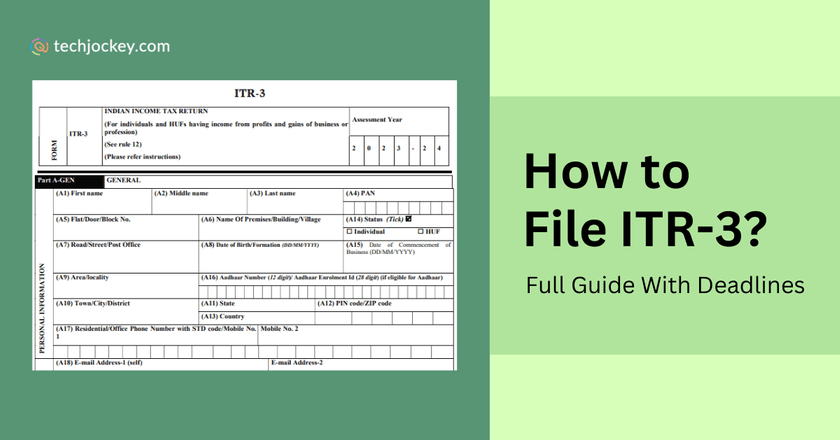Income tax filing may be daunting, particularly when you earn money through a business or profession, as there are many schedules to consider. But with proper guidance, it is possible to file ITR in less time. As there are many different types of ITR forms for different categories of income, this blog will discuss how to file ITR-3 in detail.
If you want to explore ITR-3 in more detail, you can check out our dedicated blog on “What is ITR-3”.
Here’s what we will discuss:
Structure of ITR-3 form
Step-by-step process including filling out the form, preparing the balance sheet, and handling nil returns
ITR-3 filing deadlines and more
Let’s go.
What is the Structure of ITR-3?
ITR-3 is relatively comprehensive and is targeted at individuals and HUFs whose income is earned through business or profession. The form is divided into several sections and schedules, which include a general section, balance sheets, profit and loss reports, deductions, and tax calculations.
Part A – General and Financial Statements
- Part A-GEN: General information and nature of business/profession
- Part A-BS: Balance Sheet as on 31st March of the relevant financial year
- Part A-Manufacturing Account: Details of the manufacturing account
- Part A-Trading Account: Trading account details
- Part A-P&L: Profit and Loss account
- Part A-OI: Other information (optional if not subject to audit under Section 44AB)
- Part A-QD: Quantitative details (optional if not subject to audit under Section 44AB)
Income Schedules
- Schedule-S: Income from salary
- Schedule-HP: Income from house property
- Schedule-BP: Income from business or profession
- Schedule-CG: Income from capital gains
- Schedule-OS: Income from other sources
Depreciation and Related Computations
- Schedule-DPM: Depreciation on plant and machinery
- Schedule-DOA: Depreciation on other assets
- Schedule-DEP: Summary of depreciation
- Schedule-DCG: Deemed capital gains on depreciable assets
- Schedule-ESR: Deductions for expenditure on scientific research
- Schedule-ICDS: Impact of Income Computation and Disclosure Standards (ICDS) on profit
Set-off and Carry Forward of Losses
- Schedule-CYLA: Set-off of current year losses
- Schedule-BFLA: Set-off of unabsorbed losses from earlier years
- Schedule-CYLA-BFLA: Combined statement of set-offs (in some versions shown together)
- Schedule-CFL: Losses to be carried forward to future years
- Schedule-UD: Unabsorbed depreciation

GEN Income Tax
Starting Price
₹ 3500.00 excl. GST
Deductions under Income Tax Act
- Schedule-10AA: Deduction for units in SEZ under Section 10AA
- Schedule-80G: Donations eligible for deduction
- Schedule-RA: Donations to research associations/institutions
- Schedule-80IA, 80IB, 80IC/80-IE: Deductions for various undertakings and enterprises
- Schedule-VI-A: Statement of all Chapter VI-A deductions
Minimum Tax and Tax Credits
- Schedule-AMT: Computation of Alternate Minimum Tax (AMT)
- Schedule-AMTC: Tax credit under Section 115JD
Special Income and Disclosures
- Schedule-SPI: Income of spouse, minor child, etc., to be clubbed
- Schedule-SI: Income taxable at special rates
- Schedule-IF: Details of partnership firms where the assessee is a partner
- Schedule-EI: Exempt income not included in total income
- Schedule-PTI: Pass-through income from business trusts/investment funds
- Schedule-TPSA: Secondary adjustment to transfer price under Section 92CE(2A)
- Schedule-FSI: Details of foreign income
- Schedule-TR: Tax relief under Sections 90, 90A, or 91
- Schedule-FA: Foreign assets and income detail
- Schedule-5A: Income apportionment under Portuguese Civil Code
- Schedule-AL: Statement of assets and liabilities (mandatory if income exceeds ₹50 lakh)
- Schedule-Tax Deferred on ESOP: Tax deferral details for ESOPs from eligible start-ups (Section 80-IAC)
- Schedule-GST: GST turnover/gross receipts details
Final Computation and Verification
- Part B-TI: Computation of total income
- Part B-TTI: Computation of total tax liability
- Verification: Self-declaration and authentication by the taxpayer
Documents Needed for Filing ITR-3
Before moving forward to how to file ITR-3, below are the documents that you need to keep ready:
- You must have an Aadhaar card and PAN for verification.
- Form 16 and Form 26AS are required for salary details, TDS, and yearly tax statement.
- All your business records are mandatory, such as the balance sheet, P&L, and expense details.
- You need your investment proofs for deductions under section 80C, 80D, etc.
- Interest certificates are required from banks, post offices, or home loans.
- You should have your property documents, including rent agreements, sale/purchase deeds, and municipal tax receipts.
- Capital gains, foreign asset, or bank statements are required if applicable.
- Audit Reports are required under Section 44AB in certain cases.
How to File ITR-3?
Before you start filing ITR-3, you have to choose between the online and offline modes. For online mode, you can file it through the Income Tax e-Filing portal. And for filing it offline, you have to use the Excel utility available for ITR-1 to ITR-4 for AY 2025-26, which was released in mid-2025. In this blog, we will discuss how to file an income tax return, ITR-3 online.
How to File ITR-3 Form Online?
You can file ITR online either through the Government portal directly or using an income tax software. Here is a detailed step-by-step guide on how to file an income tax return-3 via the Government portal:
Step 1: Go to the official Income Tax e-Filing portal. Log in by entering your PAN as the user ID and password.
Step 2: Go to the “e-File” section. Then, go to Income Tax Returns > File Income Tax Return. Choose the applicable Assessment Year and click on Online mode.
Step 3: Select taxpayer status as Individual or HUF.
Step 4: Now, select the ITR-3 form. You can import pre-filled data or JSON offline utility, or download draft ITR files to begin.
Step 5: Click on “Let’s Get Started” and choose the reason for ITR-3 filing.

ClearTax Income Tax
Starting Price
Price on Request
Step 7: Now, verify your pre-filled personal details and choose your tax regime from Old or New. If you are opting out of the new regime, you need to submit Form 10-IEA.
Step 8: Now fill in personal, business, and income details, which include audit details if applicable.
Step 9: Enter information into various schedules:
Schedule BP (business income), Schedule CG (capital gains), and others like Schedule AL (assets/liabilities if income > ₹1 crore).
Claim deductions under Chapter VI-A, and input TDS/income data – including Form 26AS and AIS for verification.
System auto-calculates total income and tax liability.
Step 9: Review the form ITR-3 for any errors and correct them if needed. Pay any self-assessment tax (if due). Click on the button “Proceed to Verification” and submit your return.
Step 10: E-verify your ITR-3 instantly via Aadhaar OTP, net banking, EVC, or DSC.
Note: If you are not verifying the ITR-3 form online, then you can send the signed ITR-V to CPC, Bengaluru, within 30 days.
ITR 3 filing Last Date For FY 25-26
The due date to file ITR-3 for FY 2025-26 is 31st July 2026 for taxpayers having income from business or profession. However, if their accounts require an audit, the deadline is extended to 31st October 2026. Filing ITR-3 on time helps avoid penalties, interest on tax dues, and ensures smooth processing of refunds. Timely compliance also safeguards against future legal or financial complications.
Conclusion
ITR-3 filing could seem tough for those who are not experts at filing it. But with the correct approach and the above step-by-step guide, it is far simpler.
You just need to know the form structure and have all the necessary documentation.
An early filing will guarantee you both compliance and zero penalties. By keeping yourself updated with changes, dates, and appropriate documentation, the ITR-3 filing is less stressful.
FAQs
What is the due date of ITR-3 filing?
The ITR-3 filing due date is 15 September 2025 for the financial year 2024-2025 for non-audit cases. For those who require an audit, the due date is 31 October 2025.
How to fill the balance sheet in ITR-3?
You need to provide details of assets, liabilities, and capital as of 31st March of the financial year, along with profit and loss figures, based on your business or professional books.
How to file an ITR-3 nil return?
Even if you have no taxable income, you can file a nil return by selecting ITR-3, filling basic details, and submitting the form without entering income figures.
Mehlika Bathla is a passionate content writer who turns complex tech ideas into simple words. For over 4 years in the tech industry, she has crafted helpful content like technical documentation, user guides, UX content, website content, social media copies, and SEO-driven blogs. She is highly skilled in... Read more





























